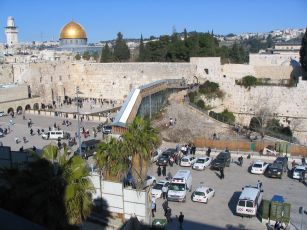Does The Guardian buy into Palestinian claims that Israel and the Jewish people have no spiritual or historical connection to the Western Wall and the Temple Mount?
 An official paper published Monday by the Palestinian Authority Ministry of Information in Ramallah, claiming that the Western Wall belongs to Muslims and is an integral part of Al-Aqsa Mosque and Haram al-Sharif (the Islamic term for the Temple Mount complex, meaning the Noble Sanctuary) barely deserves a response.
An official paper published Monday by the Palestinian Authority Ministry of Information in Ramallah, claiming that the Western Wall belongs to Muslims and is an integral part of Al-Aqsa Mosque and Haram al-Sharif (the Islamic term for the Temple Mount complex, meaning the Noble Sanctuary) barely deserves a response.
Other than to demonstrate just how low the PA is prepared to go to delegitimize Israel and the Jewish people’s connection to Jerusalem, perhaps it indicates to those who believe that settlements represent the biggest obstacle to peace, that the real obstacles are far more deep-rooted and existential.
So far, the UK media has not given this “study” the credibility that the oxygen of publicity brings with it. At some point, professional journalists need to ask themselves whether reporting the equivalent of “flat earth” theories should even be on the news agenda.
Unfortunately, either through gross ignorance or a penchant for unquestioningly accepting the Palestinian narrative, The Guardian’s Harriet Sherwood contributes to the Palestinian delegitimization Jewish history and ties to Jerusalem.
Writing about Palestinian protests over a multi-million pound development of facilities in the area of the Western Wall, described as a “major tourist site in occupied East Jerusalem”, Sherwood refers to the Western Wall as “Judaism’s most holy site“.
Wrong.
Some basic background information that Jerusalem-based journalists like Sherwood should know is that the Temple Mount – and not the Western Wall – is Judaism’s holiest site.
While this faux pas could be brushed off, Sherwood compounds the error by then promoting the Palestinian Muslim narrative at the expense of legitimate Jewish rights and history:
Immediately above the wall is the Muslim compound known as Haram al-Sharif, which houses the Dome of the Rock and the al-Aqsa mosque, the third most holy site in Islam. The area is known to Jews as Temple Mount.
Sherwood does the work of the Palestinian Authority and airbrushes out 3,000 years of Jewish history.
As Myths and Facts points out about Palestinian denials of Jewish history on the Temple Mount:
These views are contradicted by a book entitled A Brief Guide to al-Haram al-Sharif, published by the Supreme Moslem Council in 1930. The Council, the supreme Moslem body in Jerusalem during the British Mandate, said in the guide that the Temple Mount site “is one of the oldest in the world. Its sanctity dates from the earliest times. Its identity with the site of Solomon’s Temple is beyond dispute. This, too, is the spot, according to universal belief, on which David built there an altar unto the Lord, and offered burnt offerings and peace offerings.” …
The Jewish connection to the Temple Mount dates back more than 3,000 years and is rooted in tradition and history. When Abraham bound his son Isaac upon an altar as a sacrifice to God, he is believed to have done so atop Mount Moriah, today’s Temple Mount. The First Temple’s Holy of Holies contained the original Ark of the Covenant, and both the First and Second Temples were the centers of Jewish religious and social life until the Second Temple’s destruction by the Romans. After the destruction of the Second Temple, control of the Temple Mount passed through several conquering powers. It was during the early period of Muslim control that the Dome of the Rock was built on the site of the ancient temples.
Harriet Sherwood and The Guardian may not be expected to include a detailed history of Jerusalem’s holy sites in their reports. But the least that can be expected is historical accuracy.
Please send your considered comments to The Guardian – [email protected]

